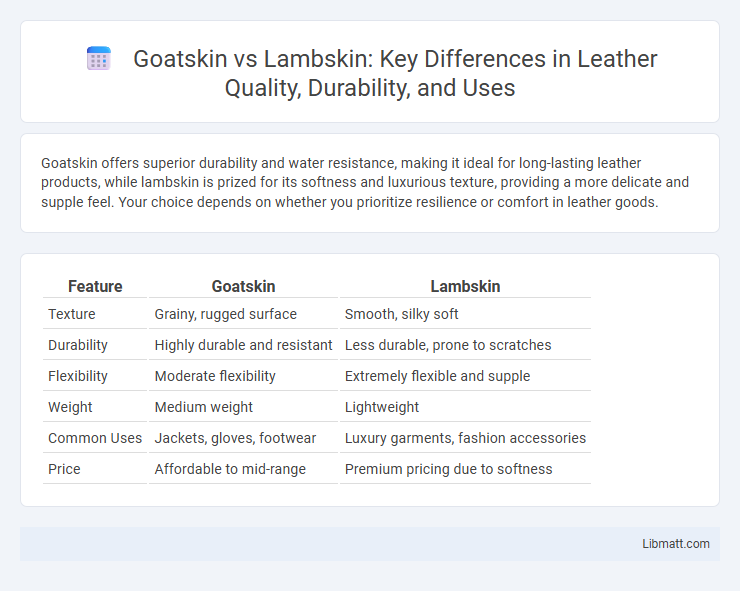Goatskin offers superior durability and water resistance, making it ideal for long-lasting leather products, while lambskin is prized for its softness and luxurious texture, providing a more delicate and supple feel. Your choice depends on whether you prioritize resilience or comfort in leather goods.
Table of Comparison
| Feature | Goatskin | Lambskin |
|---|---|---|
| Texture | Grainy, rugged surface | Smooth, silky soft |
| Durability | Highly durable and resistant | Less durable, prone to scratches |
| Flexibility | Moderate flexibility | Extremely flexible and supple |
| Weight | Medium weight | Lightweight |
| Common Uses | Jackets, gloves, footwear | Luxury garments, fashion accessories |
| Price | Affordable to mid-range | Premium pricing due to softness |
Introduction to Goatskin and Lambskin
Goatskin is a durable, textured leather known for its strength and natural grain, often used in rugged gloves, jackets, and upholstery. Lambskin is a soft, smooth leather prized for its lightweight, supple feel and luxurious appearance, commonly found in high-end fashion garments and accessories. Both offer distinct tactile qualities, with goatskin providing resilience and lambskin delivering elegance and comfort.
Key Differences Between Goatskin and Lambskin
Goatskin is known for its durability, coarse grain, and natural water resistance, making it ideal for rugged uses, while lambskin offers a softer, smoother texture with a finer grain, prized for luxury leather goods. Goatskin leather tends to be thicker and more resistant to wear and tear, whereas lambskin is more delicate, known for its suppleness and lightweight properties. The distinct textures and durability levels influence their applications, with goatskin commonly used in gloves, boots, and jackets, and lambskin preferred in high-end fashion items and upholstery.
Texture and Feel Comparison
Goatskin offers a rugged, slightly coarse texture with natural grain patterns that provide durability and a firm yet flexible feel, making it ideal for sturdy leather goods. Lambskin, in contrast, features an ultra-soft, smooth surface with a fine grain, delivering a luxurious, silky touch that is delicate and supple to your skin. Choosing between goatskin and lambskin depends on whether you prefer a robust, textured leather or a soft, elegant finish for your leather products.
Durability and Longevity
Goatskin leather is renowned for its exceptional durability and resistance to wear, making it ideal for products subjected to rough use or frequent handling. Lambskin, while softer and more supple, tends to be less durable and more prone to scratches and abrasions, which may affect its longevity. Choosing goatskin ensures your leather goods maintain strength and resilience over time, whereas lambskin offers luxury at the expense of durability.
Breathability and Comfort
Goatskin leather offers superior breathability due to its naturally porous grain structure, allowing better air circulation and moisture wicking compared to lambskin. Lambskin, while incredibly soft and supple, tends to retain heat and moisture, which can reduce overall comfort during extended wear. For users prioritizing ventilation and comfort in warmer climates, goatskin is often the preferred choice over lambskin.
Uses in Fashion and Accessories
Goatskin is prized in fashion for its durability and textured grain, making it ideal for rugged leather jackets, shoes, and sturdy handbags that withstand daily wear. Lambskin, known for its ultra-soft, supple feel, is favored in luxury items such as high-end gloves, delicate purses, and finely tailored jackets that emphasize comfort and elegance. Your choice depends on whether you prioritize resilience and a rustic look with goatskin or a smooth, refined finish with lambskin in fashion and accessories.
Care and Maintenance Tips
Goatskin leather offers superior durability and water resistance, making it easier to maintain with regular wiping and conditioning using a mild leather cleaner. Lambskin requires more delicate care due to its soft, fine grain, so you should avoid exposure to moisture and use specialized leather conditioners to preserve its texture. Your choice between goatskin and lambskin impacts maintenance frequency and methods, with goatskin generally demanding less intensive care for long-lasting quality.
Price and Value Analysis
Goatskin typically offers a more affordable price point compared to lambskin due to its thicker, more durable nature, making it a practical choice for long-lasting leather goods. Lambskin, while more expensive, provides a softer, luxurious feel that appeals to those prioritizing comfort and premium quality. Your decision should weigh goatskin's cost-efficiency and ruggedness against lambskin's high-end softness and price, aligning with your budget and usage needs.
Environmental and Ethical Considerations
Goatskin leather generally has a lower environmental footprint than lambskin due to goats' ability to thrive in arid climates, requiring less water and feed. Ethical concerns around lambskin often relate to lambs being sourced from animals primarily raised for meat, raising issues of animal welfare and by-product use. Goatskin is frequently considered more sustainable as it utilizes hides from animals already part of meat and dairy industries, minimizing waste and promoting responsible resource use.
Choosing the Right Leather for Your Needs
Goatskin offers durability, water resistance, and a distinct pebbled texture, making it ideal for rugged use and outdoor gear. Lambskin, known for its softness, smooth surface, and luxurious feel, suits high-end fashion and delicate accessories requiring flexibility and comfort. Selecting between goatskin and lambskin depends on whether durability or softness best matches your specific leather product needs.
Goatskin vs lambskin Infographic

 libmatt.com
libmatt.com